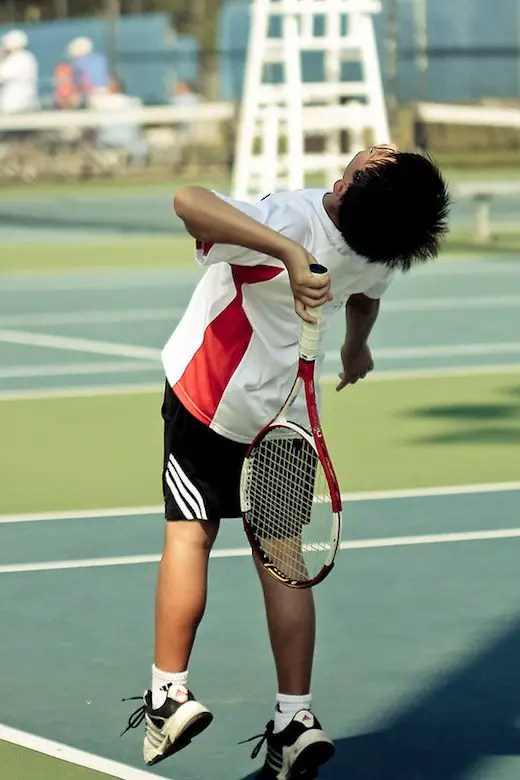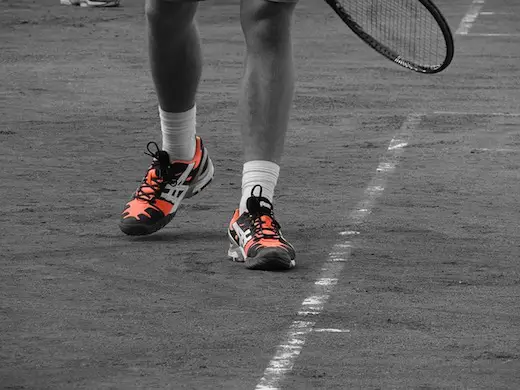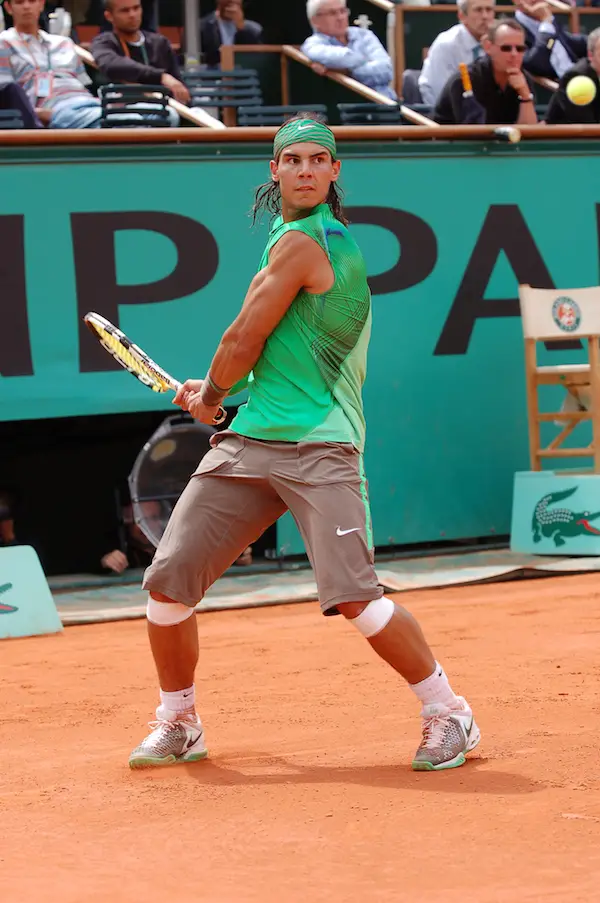As a new tennis player, you need a racquet that gives you a greater chance of HITTING the ball, and a racquet that just generally makes the learning process easier.
That is why I always recommend racquets that are light in weight, have a large head size, and are powerful enough to COMPENSATE for any lack of fundamental technique initially.
Your Guide
 Gavin Davison
Gavin Davison
You want to have fun when learning the game, and the best way to do that is to use a racquet that meets these specifications.
As we are about to embark on this journey through a whopping 75 different products, I’d like to draw your attention to a quick page from the LTA, which is the governing body for tennis in Britain.

They have QUICKLY outlined what to look for, whether you are a beginner, intermediate, or advanced tennis player.
I will be running through the reasons behind this information in great detail throughout this piece, but first you can check out their page.
#1: Wilson Blade 101L
The Wilson Blade 101L steals the number one SPOT on my list for a number of reasons. The racquet is just perfect for beginners, with an oversized head and a very lightweight frame.
These two combined give beginners a much higher chance of making contact with the ball and also allows them to wield the racquet without too much trouble.
Because that is what it is all about as a beginner. You want to be able to get a rally going, as this makes tennis FUN, and you want to be able to perform all shots without your arm falling off because of the weight!
Key Features
- Large head size to give a greater chance of hitting the ball
- Relatively light, making it easy to handle
- 23mm beam providing increased power
- Large sweet spot due to oversized head
Specification
- Weight unstrung: 274g
- String pattern: 16 x 20
- Head size: 101 square inches
- Balance: 340mm (head light)
- Beam width: 23mm
Pros
- Huge sweet spot giving the ability to hit with power much easier
- A lightweight frame, ideal for learning fundamental strokes as well as serves
- Head light racquet, allowing beginners to generate racquet head speed easily
Cons
- Head light racquets can sometimes lead to using improper technique
- Can sometimes produce more power than necessary for beginners
#2: Babolat Pure Drive 110
Babolat has historically produced QUALITY racquets for all forms of players. This includes amateurs, professionals, beginners, advanced players, and juniors.
In my opinion, they are one of the best manufacturers of tennis racquets out there.
This racquet meets many key specifications that you need to look for in a beginner’s racquet, to add to the quality. It has a whopping 110-inch head size, can produce heaps of power and it’s just generally a fun racquet to use.
This racquet also suits players with a slower swing speed, which most beginners do have since they are still learning the strokes.
Let’s get into the key features and specifications of this beauty!
Key Features
- Great power due to the large head size and huge sweet spot
- Wide string pattern for added spin and power
- Head light for easy manoeuvrability
- Suits compact swing styles, ideal for helping beginners to control the ball
Specification
- Weight strung: 272g
- String pattern: 16 x 19
- Head size: 110 square inch
- Balance: 340mm (head light)
- Beam width: 24mm
Pros
- Easy to hit various spins and generate power
- Has anti-vibration technology manufactured into the frame
- Develops power without too much flexibility on contact
Cons
- Very large head size doesn’t meet everyone’s preferences
- Can be hard to control the ball given the large power specifications
#3: Head Graphene 360 Speed Lite
Head has often been regarded as a brand that produces quite heavy and stern frames.
Yet this REPUTATION may just be shifting with the introduction of their range of speed lite racquets.
I’ve actually tried this racquet personally, and I believe that it has excellent control while being very easy on the arm.
It’s a racquet that is less focused on all-out power and is more focused on control thanks to the SOLID frame.
This almost forces beginners to learn the correct form and swings to generate power, so it can be both a blessing and a curse depending on what you want to get from your tennis game.
Key Features
- Quite an attractive frame, both in style and paint job
- Supports rapid head speed once the fundamentals are in place
- The racquet is on clearance at multiple online retailers right now
- Slightly head heavy as opposed to head light
Specification
- Weight strung: 281g
- String pattern: 16 x 19
- Head size: 100 square inches
- Balance: 348mm (head heavy)
- Beam width: 25mm
Pros
- Much easier to control the ball compared to other frames
- A head heavy frame forces the player to learn the correct technique
- Provides great power without losing the control element
Cons
- Not a great frame if you are an absolute beginner (never played before)
- Suits a medium to fast swing, which is only developed after a few hours of coaching
#4: Prince TexTreme Tour 100
While I absolutely LOVE Wilson and Babolat racquets, I feel that I should give credit where credit is due. It’s only fair, and Prince has developed an awesome frame for beginners in the form of the TexTreme Warrior.
Prince has quite a unique angle on their racquets since the frames are usually quite open, which allows for masses of racquet head speed.
This frame supports many of these CLASSIC specifications seen with other Prince racquets.
You can develop loads of topspin with this frame, and topspin is one of the most important things to learn as a beginner. Yet topspin isn’t the only attraction of this frame, as seen with the key features.
Key Features
- Wide string pattern to hit tons of spin on the ball
- Facilitates increased racquet head speed
- Larger head size without being too large
- Graphite frame for increased stability
Specification
- Weight unstrung: 285g
- String pattern: 16 x 18
- Head size: 100 square inches
- Balance: 350mm (head heavy)
- Beam width: 24mm
Pros
- Wider string pattern for increased topspin
- Allows for greater control through the head heavy frame
- Added power without increased vibration and flexibility in the head
Cons
- Some players complain that Graphite frames feel a bit dull (no feel)
- This racquet is on the pricier side – over £150
#5: Wilson Hyper Hammer 5.3
First of all the Hyper Hammer is a classic frame, and it’s served BEGINNERS well for years.
I’ve coached players of all ages who have used this frame, and the complaints have been few and far between. In my opinion, it’s very understandable why, since this racquet is very versatile.
It has quite a large head size for sure, and it is much LIGHTER than other racquets in this category, but it has these specifications while still playing like a more solid and heavier frame.
This is what provides the versatility of this frame, and it’s a frame that has stood the test of time.
Key Features
- One of the lightest beginner racquets on the market
- Very easy to handle the frame due to the weight
- Very head heavy considering the weight of the frame
- Provides power without compromising on control
Specification
- Weight unstrung: 255g
- String pattern: 16 x 20
- Head size: 110 square inch
- Balance: 11 points head heavy
- Beam width: 28mm
Pros
- Has a great blend of being lightweight while providing a head heavy balance
- One of the best selling Wilson beginner frames
- Very large head size, therefore suitable for absolute beginners
Cons
- Not a great frame for learning volleys given the head heavy balance
- The 110 square inch head size can sometimes be too big for certain players
While these are my recommended frames for beginners, some will inevitably be more SUITED to your game than others.
You may prefer a racquet with an oversized head, or a racquet that is more head heavy than headlight – it all comes down to what you prefer.
If you are unsure about any of these frames, make sure that you test them before committing to a purchase, as the last thing you want when starting out in your learning journey is to pick the wrong frame!








